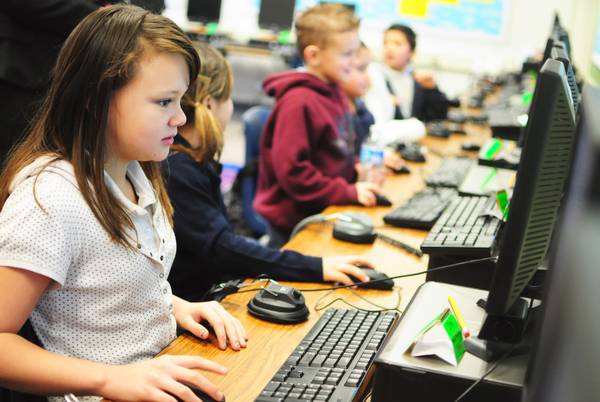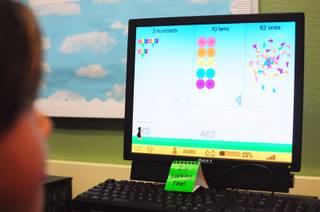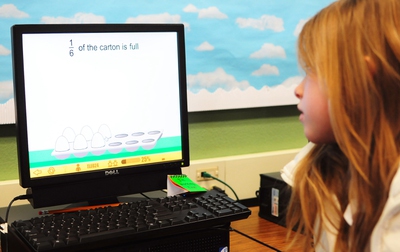Sun coverage
For all the talk about ways to raise test scores in Las Vegas, a promising solution, educators say, may lie in one of the most criticized of youth activities: computer games.
In an era where chalkboards are being replaced by Smart Boards and textbooks by iPad tablets, some educators see educational computer games pioneering the next wave in the digitization of the classroom.
The Clark County School District released on Tuesday the positive preliminary results from a five-year pilot initiative that brought the "ST Math" software to seven of the valley’s lowest-performing elementary schools: Bonner, Cortez, Decker, Diaz, McCall, Sewell and Ward. The pilot program has grown since its inception in 2009 to 32 schools, with more than 10,000 participating students this year.
Developed in 1998 by Mind Research Institute — a California-based nonprofit education group — "ST Math" teaches abstract math concepts through video game-like instruction. The game is geared toward elementary students and remedial middle school students, who guide a virtual penguin named JiJi through a series of increasingly more difficult levels and learn math concepts as they play along.
Instead of plastic cubes illustrating ones, 10s and 100s, flashy animations are used to illustrate place order and fractions. Instead of completing a quiz at the end of a textbook chapter, “ST Math” students must demonstrate 100 percent mastery of concepts before they can move up to the next level in the virtual game.
Plenty of educational software has been developed for students over the decades, but many have focused on textbook-style lesson plans complemented by game-like practice problems, said Andrew Coulson, Mind Research’s president of education.
“This isn’t a textbook on a computer,” he said of the “ST Math” software. “To get transformational changes in learning outcomes, you need a different learning environment.”
•••
That different learning environment — a computer lab full of students silently playing educational games — has translated to gains in student achievement, according to initial results from the pilot program.
At Sewell, the percentage of third- and fourth-grade students proficient in math — as measured by standardized test scores — jumped 8 percentage points between the first year of implementation in 2009 to the second.
The Henderson elementary school — which has a 60 percent poverty rate — also saw a 14 percentage point improvement in average test scores, according to Mind Research.
“There’s no achievement gap in a video game,” Coulson said, paraphrasing a colleague. “There’s a mindset that everyone can beat a video game. With this (math game), you can’t say that some kids can do math and others can’t.”
District-wide, schools using “ST Math” had more than doubled the percentage of students meeting or exceeding math standards on the state-mandated Criterion Referenced Test, compared with schools without the program, according to Mind Research.
School District officials, including Superintendent Dwight Jones and Deputy Superintendent Pedro Martinez, were on campus Tuesday, congratulating Sewell students for their achievements and applauding the results of the pilot program.
“Math can be a very difficult class for students,” Martinez said. “These students are so engaged. Kids actually like this game. It challenges their critical thinking.”
However, the percentage of Sewell students proficient in math has been steadily improving over the past decade — from 36 percent in 2002 to 76 percent last year — calling into question how much of an effect “ST Math” had on student achievement, when compared with other factors such as teacher effectiveness.
The initial results from the first seven schools also represent a small subset of the district’s 217 elementary schools — just 3 percent.
Clark County might see sustained and repeated student growth if national data is any indication, said Mind Research’s Tim Welch, director of strategic partnerships. “ST Math” is currently being used in 1,400 schools across 25 states, representing 400,000 students, he said.
Major school districts in Chicago and Los Angeles have embraced “ST Math,” Welch said, after seeing continued improvements in student test scores. He doesn’t expect Clark County to be any different.
“We’ve seen consistent growth everywhere. It’s pretty remarkable,” Welch said. “While fantastic leaders and teachers can’t be undervalued, ‘ST Math’ is the only variable that explains Sewell’s growth in the past year. It takes them to another level.”
•••
Sewell Principal Carrie Buck attributes the steady rise in student test scores to good teaching, but she also sees the “ST Math” program as an invaluable tool to reach students. Sewell started with a small group of students but eventually rolled the program out to the entire school once she saw how well students took to the game.
“This generation is very visual and reward-based,” she said. “Students love that cute little penguin character that helps them with math concepts.”
Teachers were reluctant at first about surrendering valuable class time to a computer game, Buck said. But that changed once administrators and teachers saw how effective the game is at keeping students focused on math.
Since students can progress through the game at their own pace, teachers can also create an individualized curriculum for each student, tailoring homework and practice problems to a particular student’s weaknesses. Using “ST Math,” teachers can work intensely with lower-performing students, while allowing higher-performing students to progress to higher-level math concepts on their own using the computer software, Buck said.
Because the majority of state testing is still done by paper, Buck said she is trying to ensure that students don’t lose traditional problem-solving skills. Currently, about 20 percent of instruction is done through the computer game, and practice tests are always given on paper, she said.
School officials seem hopeful that this new computer game will help more students master difficult math concepts. In recent years, the number of proficient students at Sewell had come to a plateau. Last year’s 8 percentage point gain was a hopeful sign that “ST Math” is working, said School Board member Deanna Wright, who represents Sewell.
“A lot of kids are afraid of math,” she said. “This game is opening up walls and barriers.”
•••
The School District is now looking to scale up the program from its initial 32 elementary schools, Martinez said. Currently, Mind Research and other community partners are paying for the $3 million, five-year pilot program. (After two years, Mind Research has spent $1.2 million to implement “ST Math” in 32 Las Vegas schools. That figure is offset by $300,000 in funds raised from individual donors, businesses and foundations such as Cox Charities, PricewaterhouseCoopers, University of Phoenix and Wells Fargo Foundation.)
Mind Research’s thinking is that once the program proves itself, school districts such as Clark County may decide to renew the software license, fully integrating it into the math curriculum district-wide, Coulson said. Chicago Public Schools is currently adopting the program, spending over $1 million so far, he added.
However, with the School District facing multimillion dollar budget cuts in recent years, school officials contend it might be difficult to continue playing the game of digital education.
Programs like “ST Math” require a near 1-to-1 ratio of computers to students. At Sewell, each classroom has about 10 computers, not enough for the average class size of 25. The program also requires a number of training sessions for teachers.
Although the School District awaits more conclusive results from the pilot program, Martinez and Wright say they want to stick with the computer game approach of teaching math.
Mind Research is banking on that, too.




Join the Discussion:
Check this out for a full explanation of our conversion to the LiveFyre commenting system and instructions on how to sign up for an account.
Full comments policy